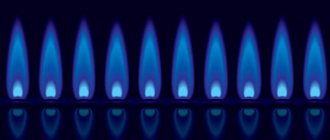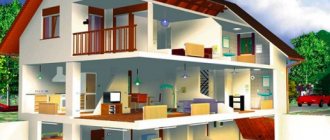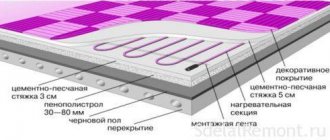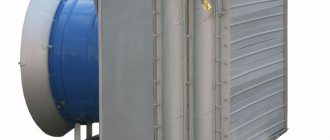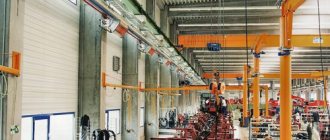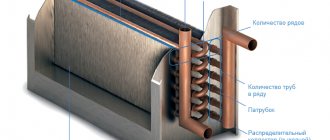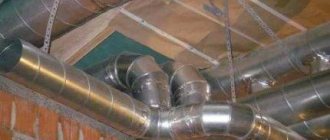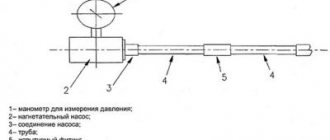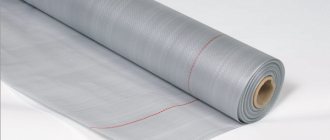Office ventilation requirements, standards
requirements apply to ventilation and air conditioning systems for Class A offices :
- heating, ventilation, air conditioning and air humidification systems must allow temperature control in a separate office block;
- the system must be able to provide round-the-clock cooling of server rooms and maintain the average temperature in offices in the range of 22–23 °C (±1 °C);
- the system must carry out air exchange at the rate of 60 m3/h per 10 m2 of rented area.
In assessing the future cost of the system, it is important to understand what the office load is. On the one hand, it is difficult to imagine that in a class A office the employees would be so densely packed that it would be difficult to walk between the tables. But at the same time, the assumption that the tenant will pay high rent for a category “A” office and provide spacious premises to employees seems even more dubious. The classification speaks of an air exchange of 60 m3/h per 10 m2. At the same time, according to Russian standards, one permanent employee must be supplied with 60 m3/h of fresh air. It turns out that according to the 2006 classification, in a class “A” office there are 10 m2 per person, which is very difficult to believe. We believe that the compilers of the classification relied not on Russian SNiPs, but on a foreign classification. For example, in the UK the air exchange per employee should be only 40 m3/h. Consequently, for each person in class A offices in London there is not 10, but 6.6 m2. This figure is already very similar to the truth. The contradiction here is that Soviet and then Russian ventilation standards are much stricter than in other countries. The figure of 60 m3/h in our standards is taken with a justified margin. Generally speaking, according to research by domestic classics, 38 m3/h is enough for a person to stay comfortably indoors. However, in the vast majority of cases, the air distribution in the room is not optimal, resulting in all the air not reaching the work area. By supplying 60 m3/h, we take into account losses due to poor air distribution. Since we live in Russia and hand over projects to Russian and not English SES, when calculating air exchange we should proceed from 60 m3/h per person or 60 m3/h for every 6–7 m2 .
How much does it cost?
Let us describe a system that meets the requirements of this classification. The building must have supply and exhaust ventilation that supplies and removes 60 m3/h per person. This is the requirement for an office building of any class. This minimum air corresponds to sanitary standards.
The ventilation system must be equipped with an air humidifier . This requirement is most often not taken seriously, although it is completely understandable. In winter, the air is very dry, and in offices the humidity reaches 15–20%. But the attitude towards air humidifiers has always been negative - they are an expensive and rather capricious device. Modern ventilation equipment does not have such problems. However, perhaps due to inertia, very few buildings still have a central humidification system. The building must be equipped with an air conditioning system, which must “maintain an average temperature in the range of 22–23 °C.”
In the summer, everything is simple - even an ordinary household air conditioner can provide a temperature of 22 °C. All difficulties appear in winter. The fact is that in winter, even in severe frost, offices are hot - lighting, a large number of office equipment, staff, and visitors emit enough heat to warm the premises to 25–28 °C. It is difficult to cool rooms in winter, because... split systems, multi-split systems, VRF systems, traditional chillers do not work for cooling in severe frosts.
There are two ways out:
- use powerful ventilation , which supplies the room with a sufficient amount of air with a temperature of 17–19 °C to “dilute” the heat (in a populated office, the air exchange rate in winter can reach 9–10 (!) and it is obvious that few people do this, since huge air ducts, many air distributors, a huge ventilation unit are expensive and inconvenient;
- use air conditioning systems that can operate in winter for cooling . These include chillers with a glycol circuit, systems with heat pumps (internal water-cooled mini-chillers) and cooling towers with a glycol circuit, and specialized VRF systems. To satisfy another classification requirement, which requires tenants to be able to control the air temperature in each office block, an air conditioning system with local controls (devices that adjust the temperature to a set point) is required. These can be indoor VRF units or fan coil units. However, now all office complexes are being delivered at the shell & core stage, and the price is being seriously reduced.
Basic requirements for system development
| Fig. 1 — Classification of requirements for ventilation and air conditioning systems |
The general requirements for the design of air conditioning systems (AAC) and ventilation for the state of the air in buildings and premises are regulated by GOST 12.1.005-88 “General sanitary and hygienic requirements for the air of the working area.” They are also set out in SNiP 2.04.05-91* “Heating, ventilation and air conditioning”. Figure 1 shows the classification of requirements for system design. Sanitary and hygienic requirements regulate
- meteorological conditions or microclimate in the room being served: air temperature, relative humidity, air speed
- air purity in the area where people are present,
- noise level in the premises
- minimum consumption of fresh (outside) air per person (see table 2)
| table 2 | |||||
| SNiP 2.04.05-91* adj. 19 | |||||
| Minimum outdoor air flow for premises | |||||
| Premises (areas, zones) | Premises | Supply systems | |||
| with natural ventilation | without natural ventilation | ||||
| Air flow | |||||
| per 1 person, m3/h | per 1 person, m3/h | exchange/h | % of total air exchange, not less | ||
| Performance | 30*;20** | 60 | 1 | — | Without recirculation or with recirculation at a frequency of 10 exchanges/hour or more |
| — | 60 90 120 | — | 20 15 10 | With recirculation at a rate of less than 10 exchanges/hour | |
| Public and administrative | According to the requirements of the relevant SNiP | 60;20** | — | — | — |
| Residential | 3m3/h per 1 m2 of residential premises | — | — | — | — |
| * With the volume of the room (area, zone) per 1 person. less than 20 m3. ** With the volume of the room (area, zone) per 1 person. 20 m3 or more. *** For auditoriums, meeting rooms and other rooms where people stay for up to 3 hours continuously. | |||||
| Fig. 2 - Classification of calculated air parameters |
Regulatory documents establish optimal and permissible air parameters depending on the category of severity of work and the period of the year.
The classification of calculated air parameters is shown in Fig. 2. Optimal parameters are considered combinations of parameters that, when systematically exposed to a person, ensure the preservation of the normal and functional thermal state of the body without straining thermoregulation reactions, a feeling of thermal comfort and the prerequisites for a high level of performance.
The optimal parameters of internal air at an industrial enterprise are established based on the situation - the requirements of the technological process are decisive, if the quantity and quality of products depends on compliance with the exact regime of the technological process. If the output of products is affected by the intensity of labor, then the comfortable conditions of working people are regulated.
Combinations of air parameters that, with prolonged and systematic exposure to a person, can cause short-term and quickly normalized changes in the functional and thermal state of the body that do not go beyond the physiological capabilities of a person are considered acceptable. (Table 3)
| Table 3 | |||
| SNiP 2.04.05-91* adj. 1 | |||
| Permissible norms of temperature, relative humidity and air velocity in the serviced area of residential, public and administrative premises | |||
| Period of the year | Air temperature, °C | Relative air humidity, % no more than | Air movement speed, m/s, no more |
| Warm | No more than 3°C higher than the calculated outside air temperature (parameters A)* | 60*** | 0,5 |
| Cold and transitional conditions | 189**-22 | 65 | 0,2 |
Design parameters of air during air conditioning should be ensured within the limits of optimal standards in accordance with the relevant building codes and regulations (Table 3 and Table 4)
| Table 4 | |||||||||
| SNiP 2.04.08-91* adj. 2 | |||||||||
| Period of the year | Category of work | Optimal standards for permanent and non-permanent workplaces | Acceptable standards | ||||||
| temperature °C | movement speed, m/s. n more | relative humidity, % | temperature °C | air speed | relative air humidity, %, no more | ||||
| at all workplaces | at permanent jobs | in non-permanent jobs | in permanent and non-permanent jobs | ||||||
| 1 | 2 | 3 | 4 | 5 | 6 | 7 | 8 | 9 | 10 |
| Warm | Light Ia IIb | 23-25 22-24 | 0,1 0,2 | 40-60 | 4°C higher than the calculated outside air temperature (parameters A) and no more than those specified in groups 7 and 8 | 28/31 28/31 | 30/32 30/32 | 0,2 0,2 | 75 |
| Moderate: IIa IIb | 21-23 20-22 | 0,3 0,3 | 27/30 27/30 | 29/31 39/31 | 0,4 0,4 | ||||
| heavy: III | 18-20 | 0,4 | 26/29 | 28/30 | 0,6 | ||||
| Cold and transitional conditions | light: Ia Ib | 22-24 | 0,1 0,1 | 40-60 | — | 21-25 20-24 | 18-26 17-25 | 0,1 0,2 | |
| Moderate: IIa IIb | 18-20 17-19 | 0,2 0,2 | 17-23 15-21 | 15-24 13-23 | 0,3 0,4 | ||||
| Heavy: III | 16-18 | 0,3 | 13-19 | 12-20 | 0,5 | ||||
Construction, installation and architectural requirements are:
- in minimizing the required equipment;
- ease of installation;
- in providing vibration and sound insulation
- in compliance with fire safety rules.
The main operational requirements include :
- low thermal inertia of the system (the ability to quickly switch from cooling to heating mode and vice versa);
- ensuring individual regulation of temperature and humidity in each room;
- simplicity and ease of maintenance and repair;
- concentration of equipment;
- partial interchangeability of air conditioning systems, i.e. When one air conditioner stops, the other must provide at least 50% of the required air exchange.
Rescue shell & core
Shell & core refers to the construction stage at which public areas have a finished appearance and are fully equipped with all engineering systems and communications, and tenants in the rented areas are provided with only connection points to the main engineering systems on the floor. As a result, when the tenant enters the floor, he receives: bends in the air ducts of the supply and exhaust systems with installed throttle valves (and fire dampers), bends with installed taps of the refrigeration system (for connecting fan coils, mini-chillers, etc.).
The tenant himself carries out the installation of air ducts and cooling supply routes throughout the floor, installs fan coil units, supply and exhaust grilles in accordance with his own layout and wishes. For tenants of class “A” office space, this scheme is optimal, because it allows tenants to do everything they need in their offices. This scheme also benefits landlords, because they do not need to pay for expensive internal equipment.
Example of ventilation and air conditioning of an office building in the shell & core stage
Four-story office building under renovation in the city center. Area - 7200 m2, ceiling height - 3.5 m. The building has two wings. The source of heat supply is water at a temperature of 90–70 °C from the heating substation. The following technical solutions have been adopted. Two supply ventilation units (central air conditioners) with damper, filter, water heater, water cooler, and sound muffler sections (each for its own wing) supply air in a sanitary standard volume of 60 m3/h per person. Taking into account the fact that 20% of all premises are allocated for corridors, bathrooms, staircases, etc., we obtain a usable area of 7200 × 0.8 = 5760 m2. Calculating 7 m2 per person, the office occupancy will be 820 people. Air flow is 820×60 m3/h = 49,200 m3/h.
Two exhaust units serve offices, separate units serve bathrooms and smoking rooms. Air ducts from supply and exhaust ventilation units leave the ventilation chambers and pass vertically through all floors, thereby forming risers. On each floor there is an outlet from the riser with a fire valve and a throttle valve. A combined scheme was chosen as the air conditioning system. In the supply system (central air conditioner), the outside air is cooled to a temperature of +22 °C. As a result, not hot street air is supplied to the premises, but air at a comfortable temperature. Fan coil units will take on the main cooling load. At the shell & core stage, we do not know the tenant’s wishes regarding the type of fan coil units and their quantity. We are only obliged to install a refrigeration supply line on each floor, through which the tenant is supplied with the required amount of cold water for full air conditioning of his areas. Each floor has two insulated pipelines (direct and return water) with shut-off valves installed on them. When the tenant moves onto the floor, he will connect to these pipelines and independently carry out wiring throughout the floor.
The McQuay air-cooled chiller unit with a cold capacity of 770 kW was chosen as a cold source. The chiller piping includes: a pump group with two pumps, a 1.5 t battery tank, a 200 l expansion tank (all three elements in a single hydraulic module housing), a make-up unit, shut-off valves, filters, balancing valves, etc. Together with the Customer's operation service, it was decided to abandon the use of a glycol circuit with an intermediate heat exchanger. Generally speaking, thanks to the glycol circuit, the chiller can operate in cool weather. In addition, the glycol circuit avoids the annual procedure of draining water from the general circuit for conservation before winter and filling the circuit with water in the spring before start-up. Since the chiller is located close to the building, we set out to find a way to dampen the noise, for this we carried out acoustic calculations and developed the design of the screens.
Natural and artificial ventilation and air conditioning must meet the following sanitary and hygienic requirements:
— create in the working area of the premises (at a height of 2 m from the floor) a microclimate that complies with the standards (temperature, humidity and air speed);
— completely remove harmful gases, vapors, dust and aerosols from the premises or dissolve them to maximum permissible concentrations;
- do not bring polluted air into the room from outside or by sucking it in from adjacent rooms;
- do not create drafts or sudden cooling in the workplace;
— be easily accessible for management and repair during operation;
— do not create additional inconveniences during operation (for example, noise, vibrations, rain, snow entering the room, etc.);
Ventilation units must have a passport, an operation and repair log, an instruction manual and a repair and cleaning schedule.
If the power of ventilation units in enterprises is <150 kW, responsibility for their operation and repair lies with the chief mechanic; with a power of 150-400 kW, a ventilation engineer is assigned, and over 400 kW, a heating and ventilation department is organized.
Ventilation and air conditioning units are complex systems consisting of many individual units and units interconnected in operation. To increase the efficiency of systems, testing and adjustment are carried out after their installation, as well as during operation. The tests are divided into three categories: commissioning, sanitary and hygienic, aerodynamic.
Commissioning tests are carried out after completion of installation of ventilation and air conditioning systems. During the commissioning process, the compliance of the installations with the design data, the initial characteristics for subsequent adjustment, as well as the technical readiness of all elements of the installation for operation are determined.
Tests for the sanitary and hygienic efficiency of ventilation and air conditioning systems are carried out after commissioning, as well as after the commissioning of new technological equipment at the design load of this equipment.
Sanitary and hygienic tests are carried out for the purpose of:
1) determination of air parameters in the work area;
2) determining the concentration of harmful gases, dust and vapors in the work area, in the supply and exhaust air;
3) drawing up balances of air, moisture, heat and balances of harmful vapors, gases, dust;
4) studies of air distribution and aerodynamics of premises.
Aerodynamic tests of ventilation and air conditioning systems are carried out to determine:
1) air flow rates in the main sections of air ducts and in all branches;
2) pressure in all air duct units;
3) values of aerodynamic resistance of system elements (ventilation supply chambers, exhaust chambers, air conditioners, filters, dust collectors, etc.);
4) air speed in the air intake and exhaust openings;
5) leaks in suction areas and leaks in discharge areas.
After testing and commissioning, the ventilation and air conditioning systems are put into permanent operation. For this purpose, a commission is appointed consisting of the head of the ventilation bureau, the head of the workshop, representatives of the design organization, an occupational safety engineer, and a representative of the sanitary inspection.
Acceptance consists of inspecting the installations, test runs, and conducting efficiency tests. Based on the acceptance results, an act is drawn up, which notes deviations from the project, the results of commissioning work, the number of construction and installation works, and a list of deficiencies to be eliminated.
Maintenance of ventilation and air conditioning systems is performed by the personnel of the ventilation bureau operation group and, first of all, by the mechanics on duty, who regularly monitor the efficiency of operation and maintain the system equipment in good condition. The efficiency of work is monitored by the readings of the control panel instruments and devices installed at the workplace. The serviceability of the equipment is checked by the staff on duty. The frequency of monitoring of individual system elements is established by the operating instructions.
For ease of use, each ventilation unit of the production building is designated by a conventional abbreviated name and serial number. SN 460-74 recommend the following abbreviated designations and numbering of installations: P2—supply installation No. 2; B1 - exhaust unit No. 1; B38 - air curtain No. 8; VOU6 - air heating unit No. 6. Abbreviations and serial numbers are painted on the fan housing or air duct.
The most common problems for class A office complexes
Power shortage
The problem is painful and... expensive. If a few years ago supplying 1 kW of electricity cost 25 thousand rubles, now this figure reaches 120 thousand rubles. Therefore, there is a sharp increase in the popularity of energy-saving equipment. For ventilation, this problem is not as acute as for air conditioning. The power of the motors of ventilation units is an order of magnitude less than the cost of producing cold by compressors of refrigeration machines. The traditional way to save energy is to choose the most economical chillers or VRF outdoor units. However, you will not see a significant difference in power consumption between expensive and economical chillers. A few years ago, McQuay launched a major campaign to promote its energy-efficient chillers, which consume 20-30% less energy. They were joined by other brands. Minimum power consumption is observed in a chiller with a remote freon condenser. However, compared to the most common air-cooled chiller, the savings are about 10%.
A radical solution to the problem of power consumption of the air conditioning system is the use of absorption chillers. Simply put, these are chillers that use a kind of chemical compressor instead of an electric compressor. This “chemical compressor” requires a powerful heat source to operate. It can be energy from gas combustion, energy from network (city) hot water or steam energy. As a result, such chillers consume electricity like several computers. However, they require gas, hot water or steam to operate. Such chillers, despite their efficiency, are still rarely used in the country.
Lack of thermal energy for air heaters
In winter, the supply air must be heated from –28.5 °C (Moscow time) to +18 °C. This requires a large amount of heat. For a simple calculation, multiply the air flow by 14 and get the amount of heat in W. Thus, 10,000 m3/h requires 140,000 W of heat. The principle of heat recovery has been known for many years - the heat of the exhaust air is transferred to cold air from the street (without mixing).
Just 7 years ago, plate heat exchangers were actively used in ventilation. However, in Russian conditions their use is ineffective, since at a temperature of –15 °C the plates froze, which required turning on the bypass line or additional heating. As a result, in the coldest weather, when energy saving is most needed, there was virtually no energy saving.
Now the market is divided into recuperators with an intermediate coolant (glycol recuperators) and rotary recuperators. The first type is advocated by specialists who do not believe that rotors can operate without freezing in 30-degree frost. The glycol recuperator does not freeze even in extreme frost, but its efficiency is no more than 50%. Our experience of using high-quality Swegon rotors in the Moscow winter with temperatures down to -33 °C (two years ago) showed that none of the ten observed ventilation units froze and did not reduce efficiency (which reached 80%). In our opinion, rotary heat exchangers can very often do a good job. Although glycol recuperators are often irreplaceable - for example, for humid or polluted air.
Impossibility of installing chillers on the roof or in the yard
Often, the roof of a building is not designed to accommodate a chiller as heavy as a KamAZ truck.
In such cases, two options :
- replace the air-cooled chiller with a water-cooled chiller and install only a cooling tower (dry or wet) on the roof. The compressor unit itself is usually located in the basement, in the technical room. For some buildings, the best solution would be to install a chiller with a remote freon condenser. It is even lighter and has smaller dimensions.
- use of internal chillers. This is an air-cooled chiller, but equipped with a powerful centrifugal fan with high pressure. The chiller is installed indoors, and the hot air from the condenser is exhausted outside through air ducts. One important limitation is that in Russia there are no internal chillers larger than 350 kW.
To maintain optimal temperature and humidity conditions, an office ventilation system is installed.
Requirements for ventilation structures
Ventilation design
Ventilation of residential premises is extremely important, and therefore there are certain requirements for it. When arranging ventilation structures, it is very important to take care of the issue of sound insulation, that is, to protect the interior from the sounds of equipment. Noisy sounds can be made by the fan, which will penetrate along with the air. In order to avoid this problem, it is necessary to pay attention to the sound insulation of ventilation systems and use noise mufflers. The use of high-quality parts will ensure reliable and silent operation of all units.
Air distribution elements such as diffusers and grilles are used to move and circulate air. They must be installed in such a way that air moves evenly throughout the room. This will avoid a situation where stagnation zones or draft zones will form somewhere, as they are undesirable.
A room ventilation system built on this principle will ensure a comfortable stay for a person anywhere, and he will not feel either cold or heat. There will be slight and almost imperceptible air movement. If these conditions are taken into account, then such a room will maintain an ideal microclimate with the necessary conditions so that a person can stay, work or relax there fully and without harm to his health.
Ventilation requirements for an office building
Ventilation in an office building must meet the following requirements:
- ensuring a flow of fresh, clean air;
- removal or filtration of exhaust air;
- minimum noise level;
- accessibility in management;
- low power consumption;
- small size, the ability to fit harmoniously into the interior.
The load on office climate systems is significantly higher compared to household ones. It is required to efficiently remove excess heat and carbon dioxide generated by equipment and employees, and supply clean and filtered air at a given temperature.
Previously used natural office ventilation systems today are not able to provide conditions regulated by sanitary standards. The operation of natural ventilation cannot be controlled; its effectiveness is highly dependent on the air parameters outside. In winter, this method threatens to cool the room, and in summer it causes drafts.
Widely used in the construction of office buildings, modern hermetically sealed windows and doors and continuous panoramic glazing prevent the passage of air from outside, causing it to stagnate and deteriorate people’s well-being.
All requirements for ventilation of office premises are specified in SanPiN (Sanitary Rules and Norms) 2.2.4.
According to the document, the humidity in the premises should be:
- at a temperature of 25 degrees – 70%;
- at a temperature of 26 degrees – 65%;
- at a temperature of 27 degrees – 60%.
Recommended air temperature 22 - 24 degrees with humidity 40 - 60%.
Classification and operational requirements for ventilation and air conditioning systems
SVK is classified according to the following criteria:
- functional purpose;
- the method of supplying and removing air into the premises of buildings (structures);
- method of organizing air exchange;
- design parameters;
- purpose;
- the principle of supplying air and heat and coolants.
Ventilation systems functionally divided into 3 types:
- supply systems provide air supply to the premises of buildings (structures); if necessary, the supplied air is subjected to special treatment (cleaning, cooling, heating, etc.);
- exhaust systems remove exhaust air from buildings (structures);
- supply and exhaust systems (the most efficient) simultaneously supply clean air and remove waste air.
According to the method of supplying and removing air into the premises of buildings (structures), systems with natural ventilation, mechanical (with mechanical motivation), and mixed (combined) systems are distinguished:
- with natural ventilation, air exchange between the street and the premises occurs due to the natural pressure difference through the leaks of the enclosing structures, window and door openings (unorganized system) or specially designed adjustable ventilation openings (organized system);
- with mechanical ventilation, air exchange between the street and the premises occurs due to the pressure difference created using special equipment;
- with a mixed system: mechanical inflow - natural ventilation; natural inflow - mechanical ventilation.
According to the method of organizing air exchange, general exchange, local and special ventilation systems are distinguished:
- general exchange systems provide complete air exchange in the room as a whole or in part;
- local systems provide air supply and/or exhaust only in areas of point sources of harmful impurities in the air;
- special systems (emergency, smoke control, etc.) are installed in technological rooms where unexpected release of harmful substances is possible, in rooms with increased fire hazard, etc.
Structurally, ventilation systems are divided into ducted and non-ducted:
- duct systems have a network of air ducts for moving air or ducts that form part of building structures;
- in ductless systems, air exchange with the street or with adjacent rooms is provided by fans installed in walls, ceilings, and coverings.
Air conditioning systems are divided into comfortable and technological according to their purpose
- comfortable systems are designed to create and maintain sanitary and hygienic conditions favorable for humans in residential, public and administrative premises of buildings (structures);
- technological systems are designed to provide air parameters that meet the requirements of the processes occurring in the premises of buildings (structures).
Based on the principle of supplying air and heat and coolants, air conditioning systems are divided into direct-flow and recirculation, central and local:
- direct-flow systems use outside air processed in an air conditioner;
- recirculation systems operate without an influx or with a partial (up to 40%) supply of outside air;
- central systems are supplied with refrigerants and coolants from centralized sources;
- local systems are supplied with refrigerants and coolants from autonomous sources installed in the premises served.
The requirements for the operation of internal control systems of buildings (structures) are divided into general and special . General requirements apply to all internal control systems of capital construction projects. Special requirements are determined by the specific functional purpose of the building (structure), as well as the special operating conditions of the building (structure). Special operational requirements are formulated in special regulatory and technical documentation and applied to specific ICS of buildings (structures) of various functional purposes and technological processes for which the building (structure) is intended. Operating rules, including rules for technical diagnostics of the internal control system, acceptance and testing of materials and products during repairs, must comply with the requirements of regulatory documents and be carried out taking into account the design features of the internal control system of the building (structure). Requirements for operational control and maintenance depend on the following design solutions of the ICS:
- type of construction, determined depending on the functional characteristics of the building (structure);
- placement of units on floors and roofs of buildings;
- routing of air ducts (on facades, building structures, etc.);
- materials of external and internal air ducts;
- design features of shut-off and control valves and automatic control devices.
The frequency of major repairs (replacement of individual elements and assemblies) of the internal control system should be provided in accordance with the estimated service life, except in cases justified by the results of the surveys. For the ICS of buildings (structures) with a centralized supply of energy resources, it is mandatory to install water and energy metering devices, which must be certified and approved for use on the territory of the Russian Federation. For effective ICS maintenance, the following requirements must be met:
- ensuring free access to elements, assemblies, assemblies and instruments of metrological control of the internal control system for adjustment and adjustment during operation;
- development by the SE engineering group of plans and schedules of measures to monitor the performance and serviceability of internal control systems, their technical maintenance, carrying out preventative maintenance, current and major repairs, taking into account the requirements and recommendations set out in the technical specifications and operating instructions for equipment and materials supplied by the manufacturer;
- allocation of premises for the location of operating personnel, storage of instruments and tools.
You can get acquainted with this information in more detail at advanced training and professional training courses: February 04 - 08, 2021 February 4 - 15, 2021 - Installation of household , semi-industrial and industrial air conditioning and ventilation systems semi-industrial and industrial air conditioning and ventilation systems (full-time training) February 11 - 15, 2019 - Service and maintenance of air conditioning and ventilation systems March 4 - 15, 2021 - Mechanic for repair and maintenance of ventilation and air conditioning systems
Source: SP 336.1325800.2017 Ventilation and air conditioning systems. Operating rules.
Office building ventilation diagram
The following ventilation standards in offices have been developed, taking into account the purpose of the room, in cubic meters per hour per person:
- manager's office - from 50;
- conference room – from 30;
- reception - on average 40;
- meeting room – 40;
- employee offices – 60;
- corridors and lobbies - at least 11;
- toilets – from 75;
- smoking rooms – from 100.
SanPiN for ventilation of office premises also regulates the speed of air movement of 0.1 ms, regardless of the time of year.
As a rule, ventilation of small office premises is carried out using several air handling units. If during the hot season the office supply ventilation is not able to lower the air temperature below 28 degrees, additional air conditioning is required.
Separate air handling units are needed in conference rooms. Additional exhaust devices - in toilets, smoking rooms, corridors and lobbies, copy rooms. Mechanical exhaust from office rooms is necessary if the area of each office is more than 35 square meters. meters.
If the total area is not more than 100 sq. meters and there are 1-2 toilets, natural supply ventilation is allowed in the office through the vents. Supply and exhaust ventilation is installed in medium and large sized offices.
Types of ventilation systems
Ventilation systems
Ventilation systems for industrial premises come in various types. Depending on the method of air movement, natural or mechanical ventilation is distinguished. Very often, the best option is considered to be a combination of these two types into mixed ventilation. Considering the purpose of ventilation and why it works, they distinguish between supply, exhaust or mixed types. This separation exists to separate those systems that are intended to deliver, to remove air from the ventilated space, or both.
Ventilation can be local or general exchange, depending on the area of exposure. The second option is the most common and its essence is that humid, heated and unsuitable air is diluted with clean air until it reaches the required levels. This type of ventilation is used if, in the room where production takes place, contaminated air is distributed equally in all zones. Such ventilation allows you to achieve constant and acceptable microclimate characteristics evenly throughout the room.
Air exchange can be reduced in volume several times if it separates and removes emissions locally, that is, where they arise. To do this, certain units are installed on equipment that emits harmful substances. Such devices help separate contaminated air and remove it. Such ventilation of industrial premises is called local. The advantage of this type is that significantly less money is required for its operation and installation.
In factories where there is a risk of sudden release of large amounts of harmful substances, emergency ventilation can be installed, which begins to work in emergency situations.
Office ventilation project
The ventilation system of an office building has a number of functions. Therefore, when designing, many factors are taken into account, regulated by SNiP rules for ventilation of office premises No. 2.09.04.87 and 2.04.05.91. The system is assembled from units of varying cost, functionality and design. The task of designers is to choose them correctly.
The following points are agreed upon with the customer:
- location of the ventilation unit;
- location of ventilation ducts;
- power of the electrical system, possibility of water supply;
- the need and ways of the drainage system;
- access to equipment after installation;
- possibility of design changes.
Design of ventilation systems for offices includes:
- calculations of heat inflows for each individual room, depending on the architectural features, purpose, taking into account the technical specifications for the project;
- calculation of air exchange;
- axonometric diagram of communications;
- aerodynamic calculation, which makes it possible to determine the cross-sectional area of air ducts and pressure losses along the network;
- selection of all necessary equipment to complete the ventilation system in the office;
- calculation of heater power in the air handling unit;
- preparation of a package of project documents.
Technical equipment is selected simultaneously with the preparation of the project and takes into account all the customer’s requirements. A properly designed ventilation system for any office increases employee productivity by 20% or more.
Stage P:
- Title page;
- The general composition of the working documentation (It is not always attached to the documentation. If it is required, it is again issued by the chief engineer of the project);
- Contents of the ventilation project volume;
- General data (the main differences from the explanatory note performed at stage P - the presence of a building plan indicating the position of the systems, a larger number of installation instructions);
- Plans of ventilation systems (in complex projects they can be supplemented with sections of loaded areas and/or ventilation chambers);
- Axonometric diagrams of ventilation systems;
- Various units (piping units for air heater of supply ventilation systems, units for air duct passages through building envelopes, air duct fastening units, fan installation units, etc.);
- Specification of products, equipment and materials;
- Air exchange table (in projects with technological processes, a table of local suction is additionally attached);
- Characteristics of heating and ventilation systems (sometimes this characteristic is required to be included in the “General Data” section);
- Other applications (this may include calculations of air exchanges for certain complex rooms, calculations of smoke ventilation, technical selections of equipment and other documents that for some reason need to be provided along with the project).
Components of office ventilation systems
Air ducts
Air is delivered to the room and removed through an air duct system. The air duct network directly contains pipes, adapters, splitters, turns and adapters, as well as diffusers and distribution grilles. The diameter of the air ducts, the resistance of the entire network, the noise from the ventilation operation and the power of the installation are closely interrelated. Therefore, for optimal ventilation performance, it is necessary to balance all indicators during the design process. This is a difficult job that only professionals can do correctly.
Air pressure is calculated taking into account the total length of the air channels, the branching of the network and the cross-sectional area of the pipe. The fan power increases with a large number of transitions and branches. The air speed in office ventilation systems should be about 4 ms.
Air ducts are assembled from flexible corrugated pipes or rigid metal or plastic. Flexible pipes are easier to install. But they resist air movement more strongly and hum. Therefore, flexible pipes are used in small offices. Sometimes the main channels are made of rigid pipes, and the branches to the cabinets are made of flexible ones. But large systems are assembled from rigid pipes.
Air intake grilles
They are installed at the point where air enters the ventilation duct from the street. The gratings protect against the penetration of insects, rodents, and precipitation into the pipe. Made from plastic or metal.
Air valves
Prevents wind from blowing when the ventilation system is turned off. Often an electric drive controlled by automation is connected to the valve. To save money, manual drives are used. Then a check spring valve or “butterfly” is attached to the valve in order to block the outlets of the ventilation ducts for the whole winter.
Air filter
Cleans the supply air from dust. As a rule, coarse filters are used that retain up to 90% of particles with a size of 10 microns. In some cases, it is supplemented with a fine or extra fine filter.
Periodically, the filter surface (metal mesh or artificial fibers) needs to be cleaned. The degree of filter contamination is determined by pressure sensors.
Heater
Used to heat street air in winter, they can be electric or water.
Electric heaters have some advantages compared to water heaters:
- simple automatic control;
- easier to install;
- does not freeze;
- easy to maintain.
The main disadvantage is the high price of electricity.
Water heaters operate on water at a temperature of 70 – 95 degrees. Flaws:
- complex automatic control system;
- bulky and complex mixing circuit;
- the mixing circuit requires special care and supervision;
- may freeze.
But with proper operation it provides significant cost savings compared to an electric heater.
Fans
One of the most important components of the entire ventilation system. The main parameters when choosing: performance, pressure, noise level. There are radial and axial types of fans. For powerful and extensive networks, radial fans are preferable. Axial ones are more productive, but produce weak pressure.
Silencer
Installed after the fan to suppress noise. The main source of noise in an office ventilation system is the fan blades. The muffler filler is usually mineral wool or fiberglass.
Distribution grilles or diffusers
Installed at the outlets of air ducts into rooms. They are in plain sight, so they must fit into the interior and ensure the distribution of air flows in all directions.
Automatic control system
Monitors the operation of ventilation equipment. Usually installed in the electrical panel. Starts fans, protects against freezing, notifies about the need to clean filters, turns fans and heaters on and off.
Functions of ventilation systems
So, the main function of such structures is to ensure a normal air exchange process. Ventilation and air conditioning of premises allows not only to supply air from outside, but also to remove exhaust air, that is, to circulate it. Ventilation includes two processes - air supply and exhaust.
The next function of ventilation is to prepare the air that enters the room and create the conditions necessary for full life. To do this, you need to filter, heat or humidify the air. Air conditioning involves reducing the air temperature, however, an air conditioner is a device that automatically starts and cools the air.
Climate control equipment for offices
- Air conditioning in the ceiling
Supply ventilation unit for office. Brings fresh air from the street directly into the office space. The outflow of air occurs by displacing it into corridors and lobbies. With an area of more than 40 sq. meters the air is evacuated directly from it. Air supply units for office ventilation are used for areas up to 100 square meters. meters;
- Supply and exhaust office ventilation systems. This is the most widely used type of equipment that provides air outflow, purification and delivery. The kit may include cooling or heating devices, humidifiers. The equipment is very diverse, but the supply and exhaust ventilation of the office must be calculated and installed by professionals. Automatic control over functionality reduces energy consumption and increases efficiency;
- Duct ventilation system in the office. Duct air conditioners with outside air are installed in small and medium-sized offices. Combined with supply and exhaust equipment that brings the outside air temperature to the required level. After which it is served to the rooms;
- Central air conditioning and ventilation in a large office. In large office buildings, the climate is controlled by chiller-fan coil systems and multi-zone VRF systems. The latter consist of many indoor units that provide different temperatures and humidity in the rooms. Central air conditioners are supply and exhaust ventilation in offices with cooling and heating units. This type of climate system is suitable for large offices that are not divided into separate rooms.
IX. Cost of implementation of projects on ventilation systems.
When assessing the cost of a ventilation systems project, it is worth considering many factors, such as: the type of building, the layout of the building, the complexity of the technology (if we are talking about industrial buildings), the presence or absence of the need to design smoke ventilation systems, and so on.
However, we bring to your attention a table for a rough estimate of the cost of designing ventilation systems for stages P and R. You can obtain more accurate information on the cost of design upon request by contacting our company.
| Cost of designing ventilation systems | ||
| Designed object | Stage P RUR/m2 | Stage P rub/m2 |
| Residential single-family houses (cottage, private house, apartment) | — | 90 |
| Residential apartment buildings | 3 | 4 |
| Underground or closed parking lots | 20 | 25 |
| Administrative buildings (office buildings, shops, shopping centers, etc.) | 50 | 60 |
| Catering establishments (restaurants, bars, cafes, canteens) | 80 | 100 |
| Swimming pools | 110 | 130 |
| Medical institutions | 120 | 120 |
| Medical institutions with clean rooms | 150 | 150 |
| Industrial buildings | 80 | 100 |
Office supply and exhaust ventilation
Duct ventilation of the supply-exhaust system is used for rooms up to 600 sq. m. meters, since the office supply and exhaust ventilation capacity is up to 8 thousand cubic meters per hour.
According to SanPiN standards for ventilation of office premises, 60 cubic meters of air per hour must be supplied per person.
SNiP ventilation of office premises requires air exchange:
- inflow 3.5 times per hour;
- outflow 2.8 times per hour.
The equipment is usually hidden behind the suspended ceiling of the utility room. Air is distributed throughout the offices by a system of ventilation ducts, the outlets of which are hidden behind diffusers or grilles.
The influx of air from the street during office supply ventilation is carried out at a height of two meters above the soil surface. The air is passed through a cleaning system, and if necessary, its temperature is lowered or increased (by an electric or water heater).
The exhaust air is discharged into a ventilation shaft or through a pipe, the end of which is located 150 cm above the roof.
To reduce energy consumption, the supply air is heated by a recuperator. It is a heat exchanger in which heat from exhaust air is transferred to fresh air. Recuperators for office ventilation are rotary and plate. The former have an efficiency of more than 75% and operate in bitter frosts. But during operation, about 5% of the exhaust air enters the room.
Plate recuperators are inexpensive, their efficiency is no more than 65%. But they become icy, and we have to provide heating.
All the necessary equipment for air treatment in the supply and exhaust system is located in one relatively small building. Duct ventilation of office premises is a combination of several modules.
To ensure the required air temperature in the office space, supply and exhaust ventilation is supplemented with air conditioners. Depending on the characteristics of the building, these can be several split systems or multisplits.
Regulatory Requirements
The ventilation design, with the exception of one-story residential buildings, undergoes mandatory state examination as part of the general documentation for the facility. It eliminates the possibility of using unreliable data that is not confirmed in regulatory documentation.
Until recently (May 2011), designers used SNiP 41-01-2003 “Heating, ventilation and air conditioning” as the fundamental document for their work. The changes that came into force after May 2011 introduced the set of rules SP 60.13330.2012, as an updated edition of the old rules. We must not forget that each SNiP or SP contains links to other documentation, including various GOSTs.
Natural and artificial
Ventilation systems
Natural ventilation is called ventilation, where the driving force is the difference in temperature/pressure of indoor and outdoor air. An artificial (mechanical) system is a system where mechanical devices are used to stimulate the movement of air masses.
Here are the main conditions:
- An effective ventilation system must ensure standard microclimate indicators and monitor their deviations.
- Mechanical ventilation is installed in those rooms where it is not possible to achieve standard indicators in any other way. It is also equipped in production facilities with hazardous emissions, where exhaust/supply filtration is required.
- A mechanical ventilation system is installed to maintain an acceptable temperature; when the natural one cannot cope, excess heat and moisture appear, disrupting the proper operation of the equipment.
- In climatic regions with a design temperature of -400C, a forced ventilation system must be installed.
- Active fire protection measures provide for air supply by mechanical ventilation to places designated for evacuation. These are staircases, airlocks and elevator shafts.
- Some rooms of public, residential and industrial buildings are equipped with natural ventilation. To do this, several conditions must be met: first, the presence of light windows, second, the volume of air per person must be 30-40 m3.
- Calculation of natural ventilation is carried out based on the difference in the densities of internal air in winter and external air +50C. This is relevant for administrative, residential and public buildings.
- At production facilities, the intensity of natural ventilation is determined according to the regulatory parameters of the transition period.
- In hot production shops, where there is an excess of thermal energy for supply, additional fans are installed. This is a system of general or local air showering.
Supply and exhaust
It is characterized by the direction of movement of air masses: supply ventilation supplies prepared air inside the room; the exhaust system takes the waste and then throws it out into the street.
Supply and exhaust ventilation
According to the type of motivation, ventilation systems are artificial, natural and combined. The main feature of the calculation is the air exchange rate, it depends on the type of room. For example, in a locker room 2-3 times per hour is enough, but in a workshop for the production of paints and varnishes it should be calculated at 15-17 times.
The main thing in calculating power is the balance of air exchange. If you remove much more air than supply, there will be a noticeable difference in pressure inside and outside. This will negatively affect the well-being of workers or the technological process.
Local and general
A general or general ventilation system serves the entire building. Local or local is designed to remove or supply air to a limited area or individual workplace.
They are also subject to a number of regulatory requirements:
- General ventilation cannot pass through several fire compartments; it is designed separately for each.
- You can design one general ventilation system for laboratories, residential, public, industrial premises of category D. The main thing is that they are located in the same fire section.
- It is prohibited to combine premises of systems with and without air recovery into one branch.
- The local system for exhausting harmful substances of the first and second classes is calculated taking into account the spare fan. It must provide standard MPC values if the main suction systems fail.
Scheme of local suction
- If emergency ventilation is installed that provides the standard maximum permissible concentration, then a backup device is not required.
- Local suction from machines is designed as a separate branch only for those substances that can create an explosive compound.
Typesetting and monoblock
Stacked ventilation consists of separate modules, each of which performs a specific function. These are fans, filter units, coolers, and automation systems. Once assembled, the units are installed under a false ceiling or in a separate room.
Monoblock ventilation consists of one block, the body of which contains all the components. As a rule, it is well insulated and does not allow noise to pass through. It is often equipped with a recuperator, which reduces financial costs for heating.
Elements of the ventilation system
These are devices and mechanisms, the main elements of which are: fans, air conditioners, supply chambers, air heaters, filters, various valves, noise mufflers. The power and configuration of each is selected by calculation, taking into account the frequency of air exchange, losses and leaks through cracks, windows and doors. Standard performance indicators for equipment are provided by manufacturers.
According to the degree of protection, equipment is classified as conventional and explosion-proof. The usual one is installed in most premises where work with flammable and explosive compounds is not carried out. Protected equipment is provided for specialized workshops and laboratories.
Ventilation in premises used for production purposes
Ventilation of industrial premises must ensure constant cleanliness of the air, as well as its certain characteristics. In order to achieve this, it is necessary to get rid of unusable and warm air, and replace it with fresh and clean air.
In premises used for production, various types of ventilation systems are used, taking into account the intensity and volume of emissions of harmful substances. In order for all systems to operate efficiently, the design and installation of ventilation equipment must comply with the following rules:
- The air that is removed from the room must be equal to the volume of air that enters. Small deviation is allowed. There are special cases when air exchange is organized so that the inflow volume is greater than the outflow volume, or vice versa. This option is also sometimes used to create high pressure, greater than atmospheric pressure.
- The placement of all structural elements must be correct, depending on the needs.
The supply of clean air should be maximum in those places where emissions are insignificant, and where they are at a high level, then attention should be paid to their exhaust. Moreover, it is important to supply air to the immediate place of work, and remove emissions from the upper level of the building. Indoor ventilation and heating - Ventilation in production premises should prevent the occurrence of overheating or hypothermia among enterprise employees.
- Ventilation must operate quietly, in accordance with permissible noise standards.
- Ventilation structures must be safe from explosions or fires, as well as be reliable and easy to use.
Calculation of ventilation systems
Calculating room ventilation at the first stage requires the correct selection of equipment that will have the necessary performance characteristics regarding the amount of air passed through (cubic meter/hour).
It is also considered very important to consider such a parameter as the air exchange rate. It characterizes the number of complete air changes within one hour inside a building. In order to correctly determine this parameter, it is necessary to take into account the norms and regulations of construction. The multiplicity depends on the purpose of using the room, what is in it, how many people, etc. Calculating the ventilation of industrial premises according to this indicator also involves taking into account the equipment, as well as the characteristics of its operation and the amount of heat or moisture that it emits. For premises intended for human habitation, the air exchange rate is 1, and for industrial premises up to 3.
The brevity metrics generate a performance value that can be as follows:
- from 100 to 800 m³/h (apartment);
- from 1000 to 2000 m³/h (house);
- from 1000-10000 m³/h (office).
Also, air distributors must be designed and installed correctly. These include special air distributors, air ducts, turns, adapters, and so on.
Ensuring reliable and proper ventilation is an extremely important and necessary system in any building.
